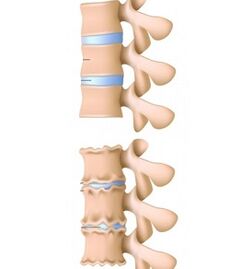
What are the causes of cervical osteochondrosis? What are the symptoms? How to effectively treat osteochondrosis of the cervical spine at home?
Cervical osteochondrosis is one of the widespread diseases that increasingly affects young people (25-40 years). The development of cervical osteochondrosis is facilitated by a long stay in the wrong, tense position - for example, working at a computer during the day or the habit of supporting the telephone receiver with your shoulder.
It is often caused by prolonged exposure to vibrations, such as working with construction equipment or driving a car. Also, improper posture, uncomfortable bed, inactive lifestyle, hereditary predisposition and other factors can lead to cervical osteochondrosis.
Cervical osteochondrosis and its causes
Cervical osteochondrosis is a degenerative-dystrophic lesion of the intervertebral disc in the cervical spine. It occurs in the background of metabolic disorders in the cervical spine, in which the structure of the intervertebral discs (special spacers between the vertebrae) and the body of the vertebrae themselves changes.
According to its symptoms, cervical osteochondrosis is somewhat different from osteochondrosis of other parts. This is the most dangerous type of osteochondrosis, because it often leads to damage to the nerve root that extends from the spinal cord and disruption of the blood supply to the brain due to compression of blood vessels. The reason is the peculiarities of the anatomical structure of the spine in the cervical zone. Thus, one of the large arteries that feeds the brain - the spine - passes right into the openings of the cervical spine process. Therefore, pathological changes in them - proliferation of bone and fibrous tissue, displacement of the vertebrae - lead to disruption of the normal functioning of this artery.
In addition, the very structure of the spine in the cervical spine is somewhat different - the vertebrae are closer together. Therefore, with any, even insignificant, pathological change in one of the vertebrae, the normal functioning of the entire section is disturbed - depression or movement of nerves and blood vessels, as well as more frequent compression of the spinal cord than in lumbar or thoracic osteochondrosis. As a result, in cervical osteochondrosis, significant dysfunctions can be noticed - sensitivity disorder of the skin and muscles of the neck, face, arms, dizziness attacks. There may be noise or ringing in the ears and head, persistent headaches, increased fatigue, blurred vision and hearing, insecurity in walking, etc.
Symptoms of cervical osteochondrosis

Of the symptoms of cervical osteochondrosis, we note the following:
- Pain in the neck, back of the head, shoulder or arm. In addition, weakness of the arm muscles, difficulty with head movements, cracking of the neck when turning or tilting the head to the side are often noticed.
- There is often a withdrawal pain in the left side of the chest, which radiates to the left arm. There may be a burning sensation or pain between the shoulder blades.
- Cervical osteochondrosis causes recurrent headaches, a feeling of weakness, and increased fatigue. The pain is usually painful and is concentrated on the hip and nape as well as on the nape of the neck. Patients often have difficulty moving their head, especially when turning in different directions.
- Neck pain can radiate to the arm and spread from the shoulder to the fist with numbness in the fingers. In this case, patients sometimes complain of "itching" or "passage of electric current" along the arms and legs when bending the neck.
- Cervical osteochondrosis can also cause hearing and vision impairment, pain in the hands, heart and lung disorders, dizziness, nausea, double vision, numbness of the face and tongue.
What is cervical osteochondrosis? What are the symptoms? How to treat cervical osteochondrosis?
Treatment of cervical osteochondrosis
Cervical osteochondrosis usually starts in a mild form and does not cause people any discomfort at first. Medical treatment is usually not needed at this stage, it is only enough to prevent further complications, improve working conditions and revise the lifestyle in favor of a healthier one.
To prevent cervical osteochondrosis, you should lead an active lifestyle, do morning exercises, follow a moderate-calorie diet, get rid of bad habits and avoid lifting heavy loads. Proper posture, proper posture while sitting and sleeping, a comfortable bed are also important factors in its prevention. Auxiliary gymnastics courses will also be useful.
However, with age, cervical osteochondrosis progresses and can progress to more serious forms. In this case, the treatment of cervical osteochondrosis is carried out by conservative methods. Among them: wearing special collars, physiotherapy, exercise, massage. In severe cases, the patient may need drug therapy - analgesics, antispasmodics, nonsteroidal anti-inflammatory drugs (NSAIDs). Physiotherapeutic procedures (paraffin, medical electrophoresis and so on) are also prescribed.
Chondroprotectors as well as B vitamins (B6, B12) have been shown for the treatment of chronic osteochondrosis of the cervical spine. Medicines for external use are widely used - ointments, creams, gels containing NSAIDs, local irritants and tissue regeneration stimulants.
Recently, a new drug has appeared in pharmacies that can provide serious help in the treatment of cervical osteochondrosis - a therapeutic analgesic anti-inflammatory patch.
Treatment of cervical osteochondrosis with a medical patch
In the therapeutic treatment of cervical osteochondrosis, various agents are used, such as NSAIDs, analgesics, antispasmodics. All of these remedies are effective, but with prolonged use they can harm the body. Therefore, it is very important to reduce side effects and improve the effectiveness of treatment. A new generation drug - an anesthetic anti-inflammatory medical patch - can help.
The medicated patch is very effective, allows you to relieve pain and inflammation, improves blood circulation in the affected area and allows you to reduce the dose of painkillers and anti-inflammatory drugs.
In the treatment of cervical osteochondrosis, a medical patch is applied to the disturbing area of the neck, avoiding the anterior surface, especially the area of the carotid arteries and lymph nodes. A course of 9 days or more is recommended. It is usually recommended to use the patch in the morning at 12 o'clock, but it is also possible to apply it at night.
High efficacy, uniqueness of composition, long-term therapeutic effect, ease of use and affordable price make the medicated patch the method of choice in the treatment of cervical osteochondrosis.






















